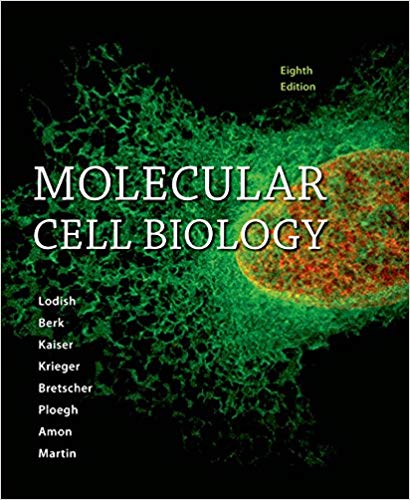Solution Manual for Molecular Cell Biology Eighth Edition
$35.00 Original price was: $35.00.$26.50Current price is: $26.50.
Solution Manual for Molecular Cell Biology Eighth Edition
Solution Manual for Molecular Cell Biology Eighth Edition

Product details:
- ISBN-10 : 1464183392
- ISBN-13 : 978-1464183393
- Author:
Grounding its coverage in experiments, Molecular Cell Biology emphasizes medical relevance while fousing on the information which defines our understanding of cell biology.
Table contents:
Part I. Chemical and Molecular Foundations
1. Molecules, Cells, and Model Organisms
Model organisms Chlamydomonas reinhardtii (for study of flagella, chloroplast formation, photosynthesis, and phototaxis) and Plasmodium falciparum (novel organelles and a complex life cycle)
2. Chemical Foundations
3. Protein Structure and Function
Intrinsically disordered proteins
Chaperone-guided folding and updated chaperone structures
Unfolded proteins and the amyloid state and disease
Hydrogen/deuterium exchange mass spectrometry (HXMS)
Phosphoproteomics
4. Culturing and Visualizing Cells
Two-photon excitation microscopy
Light sheet microscopy
Super resolution microscopy
3D culture matricies and 3D printing
Part II. Biomembranes, Genes, and Gene Regulation
5. Fundamental Molecular Genetic Mechanisms
Ribosome structural comparison across domains shows conserved core
6. Molecular Genetic Techniques
CRISPR/Cas9 system in bacteria and its application in genomic editing
7. Biomembrane Structure
8. Genes, Genomics, and Chromosomes
Chromosome conformation capture techniques reveal topological domains in chromosome territories within the nucleus
9. Transcriptional Control of Gene Expression
DNase I hypersensitivity mapping reveals cell developmental history
Long non-coding RNAs involved in X-inactivation in mammals
ENCODE databases
10. Post-transcriptional Gene Control
Improved discussion of mRNA degradation pathways and RNA surveillance in the cytoplasm
Nuclear bodies: P bodies, Cajal bodies, histone locus bodies, speckles, paraspeckles, and PML-nuclear bodies
Part III. Cellular Organization and Function
11. Transmembrane Transport of Ions and Small Molecules
GLUT1 molecular model and transport cycle
12. Cellular Energetics
13. Moving Proteins into Membranes and Organelles
Expanded discussion of the pathway for import of PTS1-bearing proteins into the peroxisomal matrix
14. Vesicular Traffic, Secretion, and Endocytosis
Expanded discussion of Rab proteins and their role in vesicle fusion with target membranes
15. Signal Transduction and G Protein–Coupled Receptors
Human G protein-coupled receptors of pharmaceutical importance
16. Signaling Pathways That Control Gene Expression
Wnt concentration gradients in planaria development and regeneration
Inflammatory hormones in adipose cell function and obesity
Regulation of insulin and glucagon function in control of blood glucose
17. Cell Organization and Movement I: Microfilaments
Use of troponins as an indicator of the severity of a heart attack
18. Cell Organization and Movement II: Microtubules and Intermediate Filaments
Neurofilaments and keratins involved in skin integrity, epidermolysus bullosa simplex
New structures and understanding of function of dynein and dynactin
19. The Eukaryotic Cell Cycle
The Hippo pathway
Spindle checkpoint assembly and nondisjunction and aneuploidy in mice, and nondisjunction increases with maternal age
Part IV. Cell Growth and Differentiation
20. Integrating Cells Into Tissues
Expanded discussion of the functions of the extracellular matrix and the role of cells in assembling it
Mechanotransduction
Structure of cadherins and their cis and trans interactions
Cadherins as receptors for Class C rhinoviruses and asthma
Improved discussion of microfibrils in elastic tissue and in LTBP-mediated TGF-B signaling
Tunneling nanotubes
Functions of WAKs in plants as pectin receptors
21. Stem Cells, Cell Asymmetry, and Cell Death
Pluripotency of mouse ES cells and the potential of differentiated cells derived from iPS and ES cells in treating various diseases
Pluripotent ES cells in planaria
Cells in intestinal crypts can dedifferentiate to replenish intestinal stem cells
Cdc42 and feedback loops that control cell polarity
22. Cells of the Nervous System
Prokaryotic voltage-gated Na+ channel structure, allowing comparison with voltage-gated K+ channels
Optogenetics techniques for linking neural circuits with behavior
Mechanisms of synaptic plasticity that govern learning and memory
23. Immunology
Inflammasomes and non-TLR nucleic sensors
Expanded discussion of somatic hypermutation
Improved discussion of the MHC molecule classes, MHC-peptide complexes and their interactions with T-cells
Lineage commitment of T cells
Tumor immunology
24. Cancer
The characteristics of cancer cells and how they differ from normal cells
How carcinogens lead to mutations and how mutations accumulate to cancer
People also search:
molecular biology of the cell 7th edition release date
is molecular and cell biology hard
essential cell biology vs molecular biology of the cell
|
molecular cell biology 7th edition ebook
molecular cell biology 7th edition table of contents
|
molecular cellular and developmental biology jobs
Related products
Solution Manual
Solution Manual
Solution Manual
International Business Competing in the Global Marketplace Hill 10th Edition Solutions Manual
Solution Manual
Auditing A Risk Based-Approach to Conducting a Quality Audit Johnstone 10th Edition Solutions Manual
Solution Manual
Solution Manual for Absolute C++, 5/E 5th Edition Walter Savitch
Solution Manual
Understanding Business Nickels 10th Edition Solutions Manual
Solution Manual











